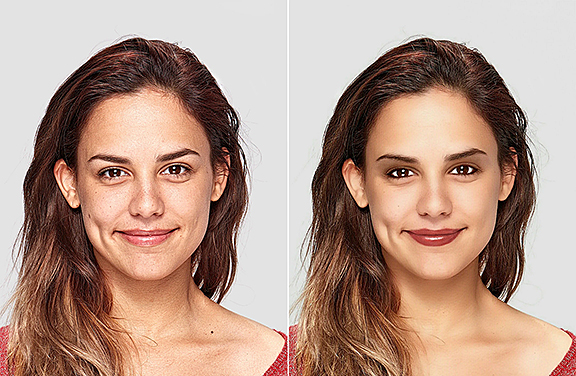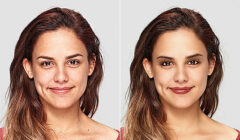Filterface
What is the face of the 21st century?
A few years back, at a family gathering, someone brought out a phone with the app Mug Life on it. For an hour or two, everyone had a hysterical time picking out movie clips or still photos to blend with an image of themselves doing some silly gesture. A face on a tennis ball, a baby smiling maniacally and saying “nope,” a pencil sketch saying “ohhh, my!”
This was fun, silly and harmless.
Next one tried: Reface. Reface is a suite of apps that you can use for fun – or fooling. One of its products is called Unboring. With it you can become a Harry Potter character (or so curse someone else), a surfer on an impossible wave, or an 1890’s trapeze artist.
Another of its products is Restyle. This product will do all the laborious work of changing your photo into a cartoon, a sketch, a superhero.
So far, apps that are mostly fun and obvious.
Another interesting one, and a slight change of purpose: FaceTune. FaceTune is a photo and video editing application that can be used to edit, enhance and retouch photos – and video. Whiten and regularize teeth, remove blemishes, smooth out skin, fix lighting, contour (get thinner or heavier?), add makeup. Yes – on video, too. As of this writing, it has been downloaded more than 60 million times.

Perhaps you’d prefer YouCam? YouCam will integrate with popular video recording/meeting software, and allows you to change backgrounds, apply filters and makeup that stays put while you’re on camera, allowing you to look perfectly turned out while you talk. Make your eyes bigger, smaller, a different color. Reshape your face, lose weight, make your lips larger or add some eyelashes, if you wish.
And of course apps like TikTok have an array of options for face adjustment and enhancement, so that you never have to appear tired, unkempt, or imperfect. Now we begin to see a problem emerging.
Is it for “fun” anymore?
Sure, artists have been adjusting the looks of their models for as long as portraiture has been undertaken, essentially as long as history. Many famous portraits of monarchs and historic faces have been made likely more beautiful than they were in real life, and as long as photos have been taken, skilled people in the darkroom were adjusting a curve there, a facial flaw there. With the advent of Photoshop, it became easier still for the subject of a photo to suddenly have perfect skin, a sweeter smile, or a more perfect nose. Granted, it took some time to learn how to do, and a funny pastime has long been finding and making sport of poorly done Photoshops of online self-portraits, where the background became thinner or more voluptuous along with the model, or lips impossibly lush were clearly an image edit on an otherwise ordinary face.
But with filters that can be applied real time on a moving subject, the common thread seems to be not so much the tell-tale artifacts, but more the tell-tale style selected. It’s not the imperfections of the technology that give away the “lie” so much as the selection of ideal features.
Just one or two side by side images will tell a story for the “perfect” female face of 2024: thin eyebrows are now unnaturally thick and with a high arch; ordinary-sized eyes have become almost Manga large; an ordinary brown iris is now glowing with yellow highlights; the mouth has very full and not-a-fine-line-visible perfection; the longish chin has been cropped just enough to create a perfect shape to the face. “Filterface.” Don’t mistake: the original women in these photos are very lovely in their own right. In fact, in many ways more so because they are REAL, and not a version of the hot young thing of (fill in a decade).

According to an article in The MIT Technology Review (https://www.technologyreview.com/2021/04/02/1021635/beauty-filters-young-girls-augmented-reality-social-media/) “These real-time video filters are a recent advance, but beauty filters more broadly are an extension of the decades-old selfie phenomenon. The movement is rooted in Japanese “kawaii” culture, which obsesses over (typically girly) cuteness, and it developed when purikura – photo booths that allowed customers to decorate self-portraits – became staples in Japanese video arcades in the mid-1990s. In May of 1999, Japanese electronics manufacturer Kyocera released the first mobile phone with a front-facing camera, and selfies started to break out to the mainstream.
The rise of MySpace and Facebook internationalized selfies in the early 2000s, and the launch of Snapchat in 2011 marked the beginning of the iteration that we see today.”
While many sources cite the playful quality of AR (augmented reality), even some useful options like trying on a haircut or clothing style to see if it suits you before you commit, more and more people are reporting being unable to share photos of themselves without the enhancements, or to accept “reality” versus their idealized self. This seems to be particularly true for young girls, whereas young boys tend to use AR for playful or teasing purposes.
The same article warns of something researchers call the “Proteus effect.” This is so named for the Greek god Proteus, a sea god who will change his shape to avoid doing things he has predicted that he does not want to endure. From his story we get the adjective protean, meaning “versatile,” “mutable,” or “capable of assuming many forms.”
Specifically, the Proteus effect was observed in virtual reality settings, and in VR gaming. In these environments, people would begin to take on the characteristics of their avatar: a tall, strong avatar would result in people more likely to behave confidently; an avatar of the opposite sex would frequently see the user behaving in stereotypical “male” or “female” ways.
However it all shakes out, the proverbial cat is out of the bag, and filters are here and ubiquitously in use. The one possible light at the end of the filter tunnel is that same ubiquity: if all online females look more or less alike, then a) it’s probably a filter; and b) it’s time to move to real, or at least, change up the filter.











